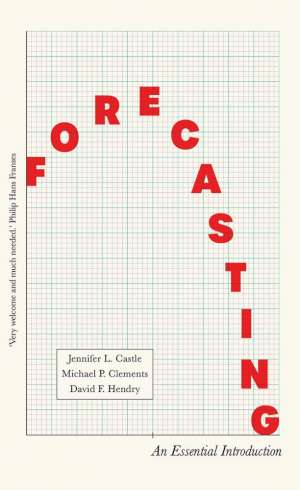02 December 2019
Forecasting: an essential introduction
Jennifer L Castle, Michael P Clements, David F Hendry
2019, Yale, 213 pages,
ISBN 9780300244663
Reviewer: Kevin Gardiner, Rothschild & Co

This is a book about a necessary task which ultimately cannot be done with confidence or credibility. The book is an attempt to formalise the unformalizable, to dignify the undignifiable.
The authors remind us that in everyday life we are implicitly trying to see into the future all the time. But they are concerned mostly with the sorts of forecasts needed for business and government budgets, and SPE conferences – forecasts of (for example) economic growth over a horizon of a few years.
I used to make such forecasts, and the authors do a good job of listing the many difficulties (that said, the fallacy of induction deserved at least a name check). They note that producing such forecasts, and the stories associated with them, can be useful even when the forecasts are wrong. I’m just not sure that the process can usefully be codified in the way they attempt.
Woven through the book is an analogy between the uncertainties we confront as economic forecasters and those faced by a motorist as she tries to estimate when she will arrive at her destination. The implication is that economics can be placed on a par with more empirically successful disciplines (like navigation and driving).
Hendry in particular has performed heroic econometric feats over many years in unravelling how economic time series might move together. He has been hugely influential: the general to specific approach to mining data carried all before it. Unusually for an econometrician, he also understands the importance of the selection of data – not just the periods and frequencies of analysis, but its meaning and relevance.
But in terms of that analogy, there can be no reliable maps and cars in economics. The empirical regularities we think we have unearthed, amongst the many moving parts we think we can track, are weak, and become unstable for reasons which often do not appear until afterwards (if then). That is not the authors’ fault, but just how it is.
In forecasting especially, the use of models has led us on a wild goose chase. The authors’ comments on the plethora of models employed to such little gain at the Bank of England hints at this, though they are too polite to spell it out.
The real world works recursively, not simultaneously: spreadsheets are perfectly adequate for most forecasting purposes, and can tell a story (which DSGE models, for example, don’t). We need those GDP projections, but let’s not obsess about them.
The interesting questions, in terms of the authors’ analogy, concern not the speed of travel, but the direction and reason for the journey. Do we face growth or impoverishment? Are debt, deflation, demographics, robotics best seen as speedbumps, or roadblocks?
The authors note Michael Gove’s comment, made during the referendum campaign, that people “have had enough of experts”, and they cite approvingly Lord O’Donnell’s riposte: “Good luck to Mr Gove repairing his car after a breakdown” (p205 – what is it with economists and cars?). But I understood what Gove meant: when it comes to talking about hypothetical future scenarios, there can be no experts.
That should be the point of the book. Instead it tries to develop expertise. A quote from page 79 is representative:
“Economic forecasts go badly wrong because of unexpected events which shift the distributions of economic variables.”
Arguably, “unexpected events” are the very definition, not the explanation, of forecasts going wrong. And there is nothing especially “economic” about this insight. But if you think that that sentence tells you something useful, then this could be a book for you.
